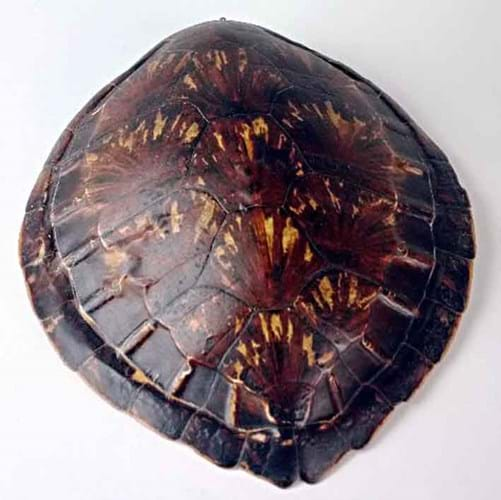
Lacquered and polished marine turtle shells do not qualify as worked unless the taxidermied animal is still attached to the shell. This includes the ‘bleached’ carapaces that have proved so popular with the interior design trade in recent years. This early 20th century shell sold at Rogers Jones of Colwyn Bay in February 2013 for £50.
The changes, introduced quietly in May without trade bodies being alerted, come under new guidance issued to CITES Management Authorities on the application of the "worked specimens" derogation. This has traditionally exempted most antiques from controls on the trade in endangered species.
More than a month after the changes were published on the DEFRA website, news is only just filtering through to the UK trade associations. Communication has been poor. No trade bodies (including the UK Guild of Taxidermy) had been informed of the guidelines, with the result that some auctioneers and dealers will unknowingly have contravened the new rules.
When Clive Stewart-Lockhart, managing director at Woolley & Wallis, mentioned the new measures to 20 or so regional auctioneers at the recent RICS seminar (June 11) his words were "met with stunned amazement".
"Worked Item"
The "worked item" derogation states that an item including the "parts and derivatives" of endangered species shall be exempt from normal sales controls laid down by the United Nations Convention on International Trade in Endangered Species of Wild Flora and Fauna (CITES) if it was acquired prior to June 1947 and has been significantly altered from its natural raw state for jewellery, adornment, art, utility or musical instrument.
With some exceptions (notably rhinoceros horn), antiques qualify under the derogation. Stuffed animals are considered "worked" and do not therefeore require a licence.
However, the term "worked" has long been open to interpretation.
DEFRA announced the changes via their website on May 9. At the heart of the policy shift is a fresh interpretation of the law, which means a volte face on a raft of items previously considered "worked" - and therefore exempt - that now require an EC certificate before they can be offered for sale.
The guidelines (intended only for internal use by Member States' CITES Management Authorities) aim to remove some of the grey areas that allowed different member states to interpret the worked derogation in different ways. An appendix to the guidelines includes images and an explanatory narrative for a number of previously 'borderline' objects, including narwhal tusks, marine turtle shells and sawfish rostrums - all of which now require an 'Article 10' certificate before they can be legitimately sold.
Ivory Tusks
The definition of what constitutes worked elephant ivory has also changed significantly. For tusks or sections of tusks to be considered worked they need to be fully carved across "the whole surface".
Uncarved tusks will no longer qualify as worked even when polished and permanently mounted as part of decorative or functional object. Accordingly - while it is perfectly legal to own them - an Edwardian dinner gong or silver-mounted candlesticks with tusk supports can no longer be offered for sale without an EC certificate.
Following the changes, a silver-mounted centrepiece by Walker & Hall, Sheffield, 1928, incorporating an elephant tusk (estimate £4000-5000) was withdrawn from Bonhams' silver sale on June 19.
Antlers or horns of any CITES listed species (including horns still attached to the skull plate and mounted on a wooden plaque) are no longer considered worked, while jewellery where the CITES specimen has been used without being substantially altered (for example a tiger claw or a humming bird) must also be accompanied by Article 10 clearance.
Admin Fees
The certification process is undertaken by the Wildlife Licensing & Registration Service in Bristol (SSC Bristol) at a current cost of £31 per item, although charges are scheduled to increase to £68 by 2015.*
The consensus is that additional red tape and the administration fee (due each time an item is sold) will have a negative effect on the market and particularly at the lower reaches where the cost of the certificate would form a significant percentage of the potential selling price.
Already the handful of auctioneers who have been informed of the new rules are reluctantly turning away items for sale.
Sarah Percy-Davis, chief executive of LAPADA, The Association of Art & Antiques Dealers, toldATG: "While we appreciate the good intentions behind the amendment, broadening the scope of what constitutes an unworked specimen requiring an EC certificate is yet another administrative burden from the European Commission which will ultimately hit small antiques businesses and will make the trade of many low-value items falling within this scope financially unviable."
Clarification on the changes can be sought from SSC Bristol on +44 (0)117 372 8774.
* Following a public consultation, from June 24 the cost of an 'Article 10' certificate will now be £31 (up from £25), with charges scheduled to increase to £68 at the beginning of 2015. The price of a re-export permit, necessary for sending elephant ivory and tortoiseshell outside Europe, has come down from £47 to £37.




